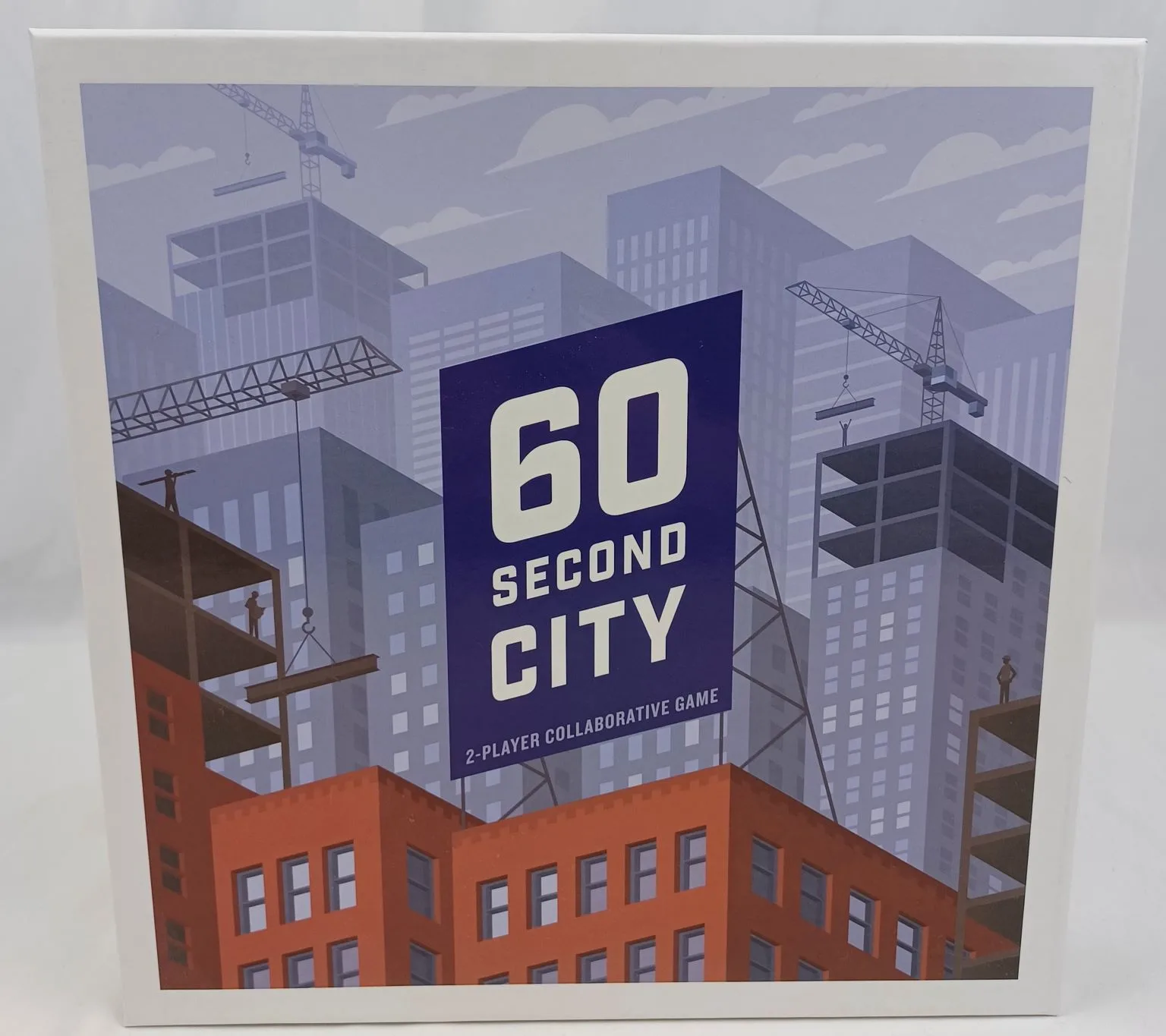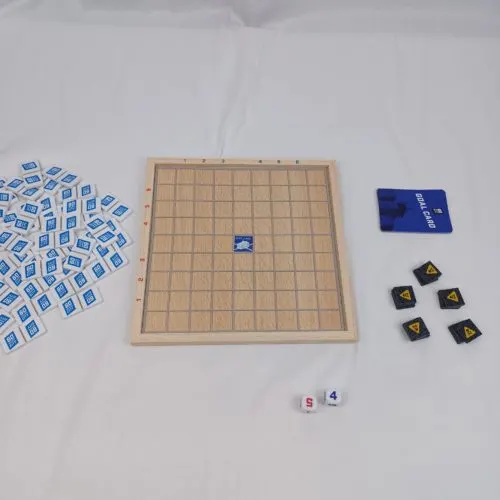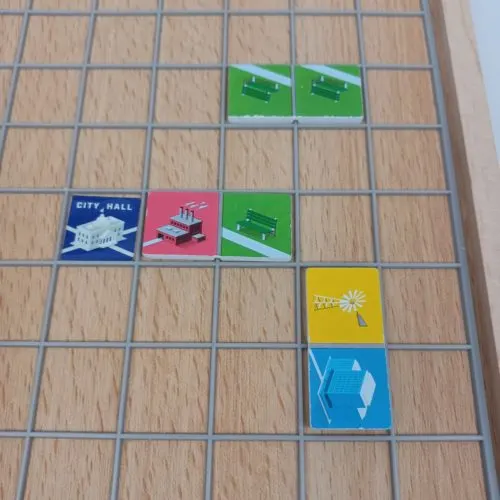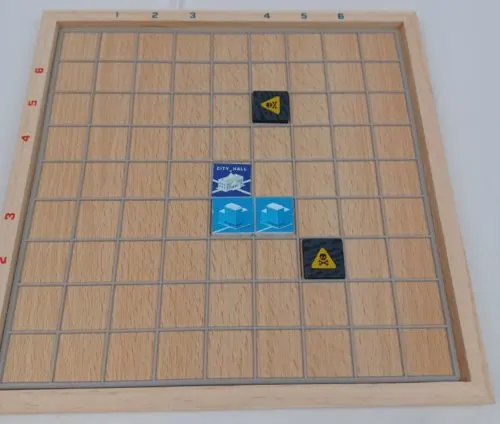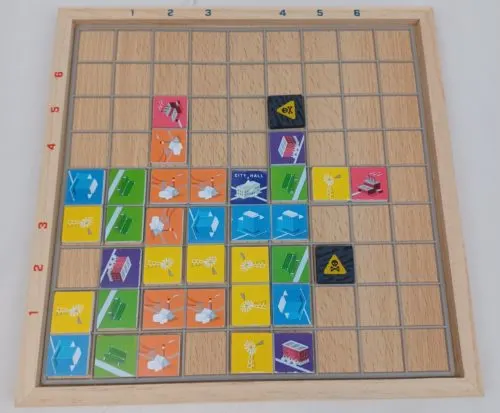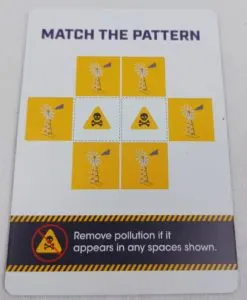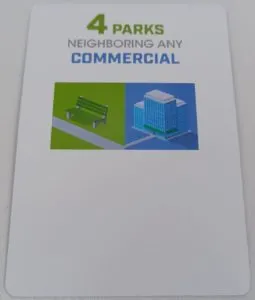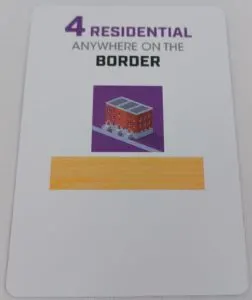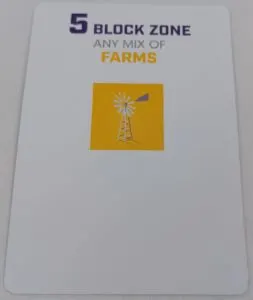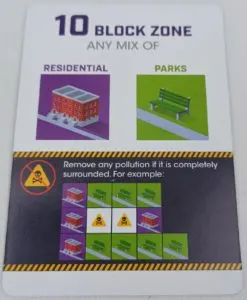When most people think of board games they think of heated winner take all competitions where you must try everything that will increase your odds of winning. While competition was the main premise behind most games for a long time, cooperative board games have really started to make a name for themselves in recent years. I enjoy a good competitive game, but it is hard to beat a good cooperative game where players must work well together in order to succeed. Whenever I see an interesting new idea for a cooperative game I want to check it out. This is what really intrigued me about 60 Second City as it created a cooperative game for two players who have to build a city in 60 second increments in order to complete various objectives. This seemed like the type of game that would be right up my alley. 60 Second City is a pretty unique experience creating a fun and fast paced cooperative game that fans of the genre will likely really enjoy.
How to Play 60 Second City
Setup
- Place the game board in the middle of the table between the two players along with the two dice.
- Place all of the City tiles face-down to the side of the game board.
- Place the Pollution tiles face-up into five stacks with three tiles in each stack.
- Find a 60 second timer to use for the game.
- Remove the 12 Event cards from the deck and set them aside. They will only be used in the advanced game.
- Choose the level of difficulty which determines the number of Goal cards that you will use in the game. Shuffle the Goal cards and keep a number equal to the difficulty you choose below. The rest of the cards are returned to the box.
- Starter – 12 Goal cards
- Standard – 16 Goal cards
- Difficult – 20 Goal cards
- Expert – 24 Goal cards
Playing the Game
The game is played over five rounds. Each round consists of the following phases.
- Set Up
- Play
- Score
Set Up For Each Round
Place new Goal cards face-up on the table until there are a total of five cards. Any Goal cards not completed in a previous round will stay in place until they are completed. The one exception to this is the last round of the game where you will turn all of the remaining Goal cards face-up no matter how many cards are left.
Next you will place Pollution tiles on the game board. You will place three Pollution tiles each round. One of the players will roll both dice which will give you coordinates for where you will place the tile. You will do this for each Pollution tile that you have to place.
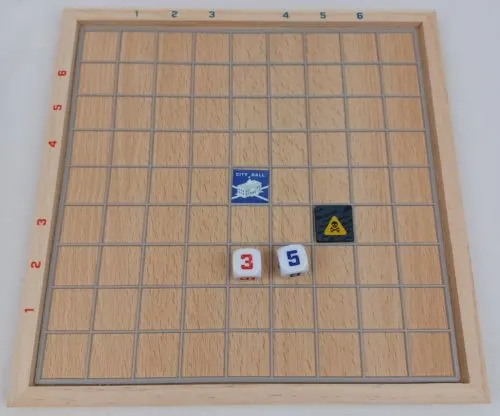
For this round the players rolled a red three and a blue five. They will place a Pollution tile on the red three blue five space.
If the space already has a Pollution tile on it, you will discard the Pollution tile you were about to place as you don’t have to place it.
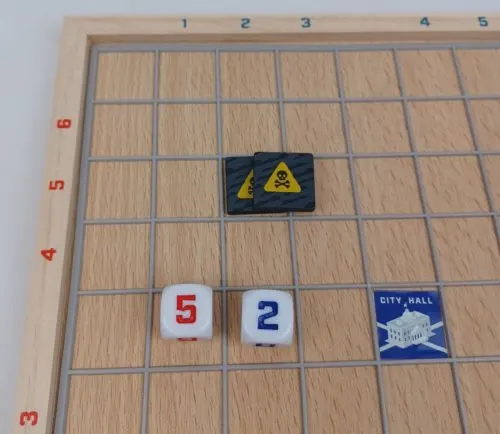
The players rolled a five on the red dice and a two on the blue dice. As there was already a Pollution tile on this space, the latest Pollution tile will be discarded.
Play
When both players are ready you will start the 60 second timer and start playing. Both players will play at the same time and can play tiles as quickly as they want. As 60 Second City is a cooperative game, players may discuss strategy at any time and take as long as they want.
Both players will choose one of the face down City tiles and flip it over. They will then choose an unoccupied spot on the board to place the tile. After placing a tile the player can draw another tile and continue playing. When placing tiles the following rules must be followed.
- A tile can be placed on any unoccupied space that shares an edge with at least one tile that has already been played (diagonals don’t count).
- The first tiles played during a round must touch one of the edges of the City Hall.
- City tiles can never be placed on top of another City tile or a Pollution tile.
- Once a tile has been placed, it cannot be moved for the rest of the round.
- Players can only draw and play one City tile at a time.
Players will keep drawing tiles and placing them until the timer runs out. If a player still has a City tile in their hand when the timer runs out, they will be able to place it on the game board before scoring is conducted.
Score
After the timer has run out, the players will start checking the Goal cards to see how many they completed. How Goal cards are completed are detailed below in the Goal Cards section.
Any Goal cards that are completed successfully will be set aside into a score pile. If a Goal card is completed and it allows the player to remove Pollution tiles, you will remove them from the board as illustrated on the card.
Any Goal cards that are not completed will stay in place and the players will have to try and complete them in the next round.
All Pollution tiles that weren’t removed due to the completion of a Goal card will stay in place for the next round. All City tiles will be removed from the board, placed face down on the table, and shuffled.
The timer is reset to 60 seconds for the next round.
End of Game
The game ends after the fifth round has been played. Players will determine how successful they were by how many of the Goal cards they completed during the game.
- “True Urban Visionaries! This game amuses you.” – Complete all of the Goal cards before the fifth round.
- “You have each risen to the ranks of City Architects!” – Complete all of the Goal cards during the game.
- “Good Job. Master Builders.” – Complete all but one or two Goal cards.
- “You’re adequate Urban Planning Undergrads (but stick to the books).” – Complete all but three or four of the Goal cards.
- “You are still cutting your teeth as Apprentices.” – You did not complete five or more of the Goal cards.
Goal Cards
There are five different types of Goal cards which must be completed in different ways.
Match the Pattern – To complete the card you must recreate the pattern shown on the card somewhere on the game board. If you complete the pattern exactly as pictured you have completed the Goal card. If the pattern features pollution spaces, those are optional and don’t have to be part of the pattern. If there are Pollution tiles in the indicated areas though, they will be removed from the game board.
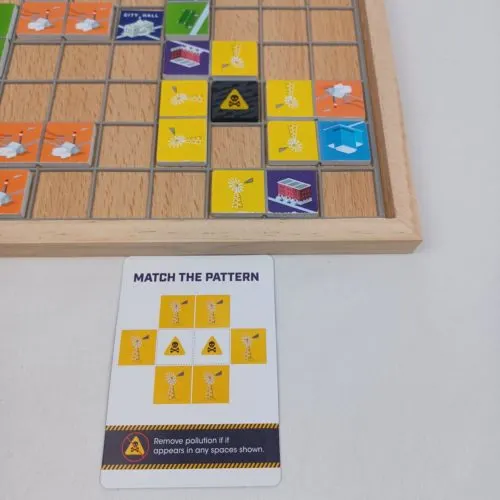
The player have matched the pattern from the card in the bottom right corner of the board. This will complete the Goal card. As there was a Pollution tile inside the pattern, it will be removed from the board.
Neighbor Goals – These Goal cards require you to have two specific block types next to one another. If one of the block types is next to two or more different blocks of the other type, it will count for as many times as the pairing is made. If Pollution is part of the Neighbor Goal and you complete the card, you may remove the associated Pollution tiles from the game board.
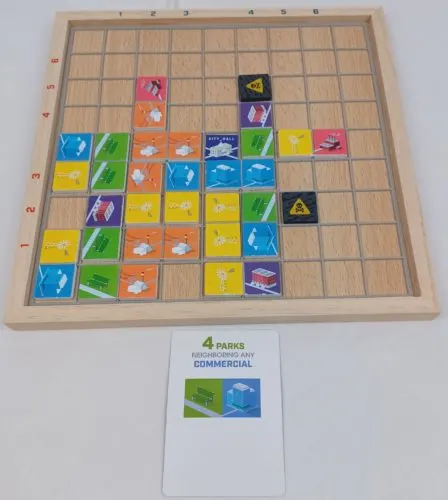
For this goal the players had to place four parks next to commercial buildings. The park next to the Pollution tile will count as two as it touches a commercial on the top and bottom. The park next to city hall will also count due to the commercial building below it. Along the left side of the board there are two more parks that touch a commercial area. As the players have five parks that neighbor commercial areas, they have completed the Goal card.
Border Cards – To complete this type of Goal card you must have the associated number of blocks that touch the outside border of the city.
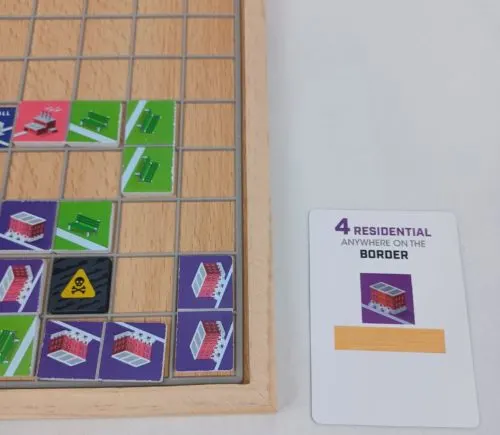
The players have successfully placed four residential areas that touch the border of the board. They have completed the Goal card.
4, 5, and 6 Block Zones – This Goal type requires you to connect the associated number of the type of block pictured into a contiguous group. This includes blocks that share at least one side, but does not include diagonals.
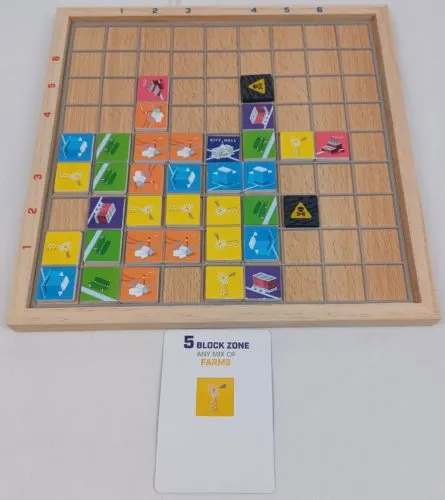
Along the bottom of the city there are five farms that are connected to one another. The players have successfully completed this challenge.
10 Block Zone – For these goals you must have at least 10 blocks of the associated types connected to one another in a contiguous group (does not include diagonals). You must have at least one of each color in the group, but there is no other requirement for what types of blocks need to be in the group. Pollution tiles that are surrounded by the group will be removed from the game board.
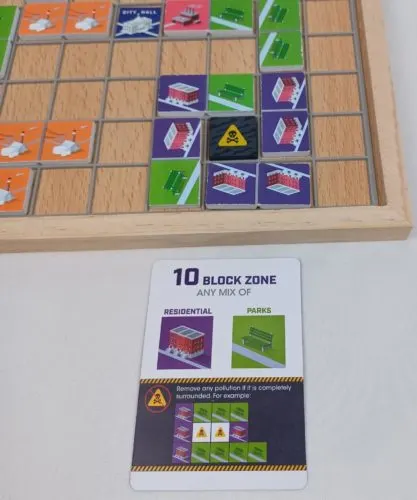
The players have successfully created a block featuring eleven residential and park areas. This completes the Goal card. As there is a Pollution tile enclosed by the block, it will be removed from the board.
Advanced Game
If you want to play the more advanced game you can add the Event cards to the game.
Shuffle the Event cards. At the beginning of each round draw the top card and read it out loud. Whatever is written on the card must be followed for the rest of the round.
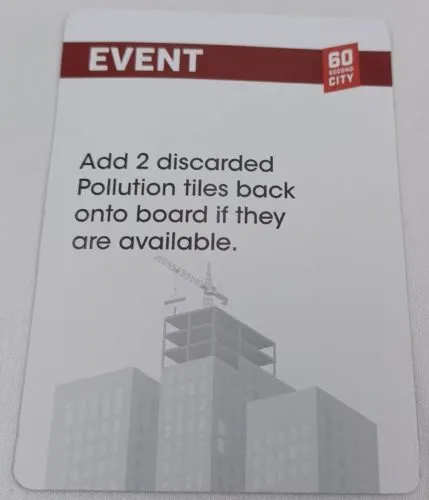
For this round the players have drawn this Event card. They will add two Pollution tiles that they removed on a previous turn(s) back onto the board.
My Thoughts on 60 Second City
Heading into 60 Second City I would say that I had pretty high expectations for the game with some hesitation mixed in. The premise of a cooperative speed tile placement game sounded like a lot of fun. The idea of trying to build a city within 60 seconds in order to complete certain objectives was intriguing. The main reason I was a little skeptical is that it was made by Buffalo Games which makes some solid games, but generally tries to create games for a more mass appeal audience. While the game is not perfect, there were a lot of things that I liked about it.
On the surface the game is a lot like what I initially expected. The game was made to try and appeal to a more broad audience including people that don’t play a lot of board games. While it is actually a pretty unique experience, it shares quite a bit in common with your typical mainstream board game. The game has a slight learning curve due to it being pretty unique, but the gameplay is generally quite straightforward. This will really help attract players that don’t usually play many board games. I would guess you could explain the rules within five minutes or so. It then may take a couple rounds for a new player to fully grasp what they are trying to do. Basically the game has some strategy to it, but you never have to put too much thought into what you are doing.
With a title placement game like 60 Second City you would think the game would play rather quickly and in fact it does. The game basically consists of five 60 second rounds. The game takes longer than this though due to the setup and scoring between the rounds as well as the strategizing. I would guess most games would only take 20 minutes though unless you spend way too much time analyzing every potential option before starting a round. This makes it a pretty good filler game where it can break up longer games, allows you to quickly play a couple games, or it can fit right in if you don’t have much free time.
While 60 Second City has a lot in common with most mainstream games, it actually shares quite a bit in common with more typical designer games as well. I have played close to 1,000 different board games and I can’t recall ever playing a game quite like it before. That is actually quite rare and is a compliment to the fact that the game actually tried to do something original. While I have played speed tile placement games before and plenty of cooperative games, I can’t recall playing a game that mixed both elements together. On its own the tile placement mechanic is similar to other games that I have played. The 60 second rounds play quickly though and keeps you on your toes as you can’t ever spend too much time thinking about what to do with any specific tile or you won’t complete many Goal cards. This leads to a fun game experience unlike most other games that I have played. Rounds will really fly by where you won’t believe that 60 seconds have already passed. If the premise sounds interesting to you at all, you likely will really enjoy it.
While 60 Second City itself is easy to play, I don’t know if I would say that it is particularly easy to win. When I first started playing my first game I thought it would be really easy to complete all of the Goal cards within time. That changed quickly as the first game progressed as you start to realize that you need to consistently complete several Goal card each round to stand any chance of winning the game. One bad round and your chances of winning are hurt significantly. Basically to beat the easiest level you need to complete around two Goal cards each round. The highest difficulty almost requires five goal cards per round.
I wouldn’t say that the difficulty is so hard that you will never win, but you might be a little surprised that the game is harder than you initially expected. Some of this is due to luck as the tiles and Goal cards you select in a round can have a decent impact on what happens. Otherwise the difficulty comes from figuring out how to complete enough Goal cards in a round and being able to adjust when things don’t go your way. Communication and teamwork is key in the game. Once a round begins you need to focus on what you had planned to accomplish in the round. The players need to have a strategy going into a round and then work together once that plan has to change. 60 Second City is the type of game that you get better at the more you play it. Even after a couple of games you will notice how much better you are as you have a better idea of how to approach each round in order to succeed.
This is one of the main reasons why I think 60 Second City works. The game really relies on the cooperative element. No matter how good you are at the game, you can’t win without working well with your teammate. There is not enough time for one player to “dominate” the game as both players need to work at a quick pace if you want to complete enough Goal cards in a round. The only way to win is for both players to pull their weight which really makes both players feel invested in what ultimately ends up happening. While you can change your strategy on the fly and likely will have to, there is a degree of strategy to the game before you start each round. The two players basically need to create a game plan of how they are going to address the various Goal cards and come up with a sort of framework for where on the game board they will dedicate to each Goal. I wouldn’t say that strategy is a huge proponent of the game, but without a plan you will fail.
Part of planning out how you are going to address the Goal cards revolves around the Pollution tiles. These tiles basically act as roadblocks as they get in your way. While you won’t have to deal with a lot of Pollution to start the game, it can really start to build up if you don’t at least try to remove some of it. If there are too many Pollution tiles on the board it will be hard to complete objectives as they will block you from building in larger areas. While you can’t focus entirely on eliminating Pollution tiles, you need to at least try to work in ways to get rid of it when you can. You could get lucky and roll combinations that won’t put out new Pollution tiles, but you generally want to restrict the number of tiles in play or it might eventually get to the point where it will basically be impossible to complete the remaining Goal cards.
As for 60 Second City’s replayabilty I would say that it is generally pretty good. The combination of Goal cards in play, locations of Pollution tiles, and the City tiles that are drawn make it very unlikely that you will ever encounter the same situations twice. The gameplay is simple, but with the speed mechanic mixed in things move quickly where it remains fun. Probably the biggest problem that I had with 60 Second City though is the fact that it is the type of game that is better in shorter doses. The gameplay never drastically changes so each game will feel very similar. Thus the game will feel a little repetitive after a while. For this reason I see 60 Second City being the type of game that you play one to three games of and then put it away for a while before you bring it out again. I just don’t see it being a game that you will play all the time as I think it will start to become kind of repetitive.
Typically Buffalo Games is a publisher that I would generally consider a mainstream board game publisher. What I mean by this is that they generally try to make cheaper games that try to appeal to a more broad audience that might not play a lot of board games. As I have detailed above, it succeeds in this task for the most part. The game is rather cheap as well as it only retails for $18 which is quite a bit less than your typical designer board game. With the game being on the cheaper side I was curious about how the component quality would hold up.
Generally speaking I was impressed in some areas and disappointed in others. On the positive side I was genuinely impressed that many of the game’s components are actually made of wood. All of the tiles and game board are made of wood. Any regular readers of Geeky Hobbies will know that I love wood components as they just feel like a higher quality than something made of plastic or cardboard. The game board actually works pretty well since the tiles fit in place pretty firmly. The game has plenty of tiles and has enough cards to keep things fresh where two games will likely never play out the same way.
I had two main problems with the components though. First the paint on the wood tiles peels/chips off rather easily. Some had already come off before I even opened the box and if you aren’t careful with the tiles it likely will continue happening over time. There is also a misprint in either the rules or game board as the numbers are in different positions in both. The main problem with the components are the cards. It has been a long time since I have played a board game with cards even close to as thin as the cards included in 60 Second City. If you are careful with them they should last, but I think they could become creased rather easily.
Should You Buy 60 Second City?
As I am always intrigued to check out new board games with interesting premises, I was really interested in checking out 60 Second City. The idea of a cooperative tile placement game where you have 60 seconds to build a city that meets certain objectives sounded like a lot of fun. In many ways it is. I have played a lot of games and I can’t recall one that played quite like 60 Second City. The speed elements mixed with the tile placement city building mechanics work really well. The game is a great cooperative game as players need to strategize together, communicate well, and generally have great teamwork in order to succeed. The game is quite easy to play and it plays rather quickly. The game can be more challenging than you would expect though. Probably the biggest complaint I have with the game is that it is better in shorter doses as the gameplay doesn’t differ enough where you will want to play it constantly. The component quality is quite impressive in some areas and kind of disappointing in others.
My recommendations for 60 Second City really depends on your thoughts of the premise as well as cooperative, tile placement, and speed games. If you aren’t a fan of these things, 60 Second City may not be the type of game for you. If the game seems like the type of game that you typically enjoy though, I think you should really look into picking up 60 Second City.
Buy 60 Second City online: eBay. Any purchases made through these links (including other products) help keep Geeky Hobbies running. Thank you for your support.
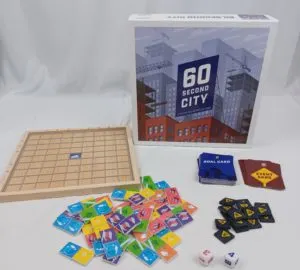
60 Second City
Year: 2021
Publisher: Buffalo Games
Designer: Ken Gruhl, Quentin Weir
Genres: Card, Family, Set Collection
Ages: 10+
Number of Players: 2
Length of Game: 20 minutes
Difficulty: Light
Strategy: Light-Moderate
Luck: Light-Moderate
Where to Purchase: eBay. Any purchases made through these links (including other products) help keep Geeky Hobbies running. Thank you for your support.
Pros:
- Fun and interesting combination of cooperative, speed and tile placement mechanics.
- An unique game play experience that is simple enough that almost anyone can play it.
Cons:
- Better in shorter doses and the gameplay doesn’t drastically change between games.
- The component quality is kind of hit or miss.
Rating: 4/5
Recommendation: If the premise intrigues you and you generally enjoy tile placement, speed, and cooperative game.

